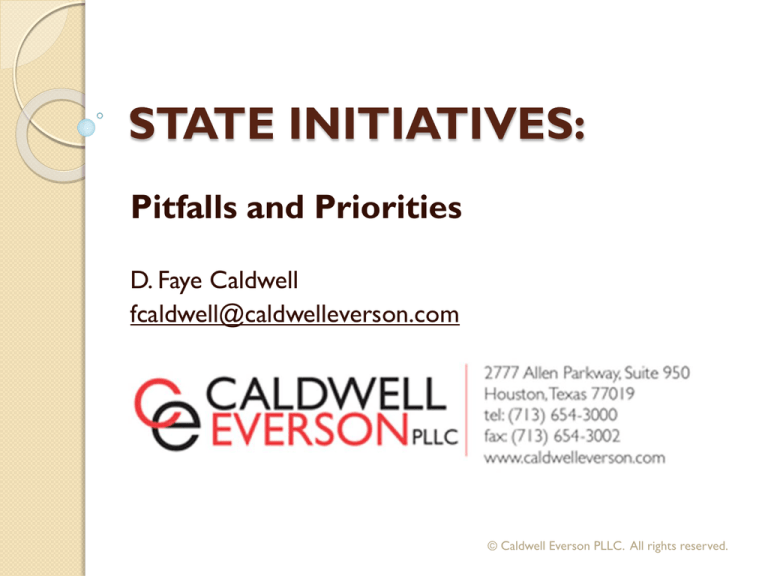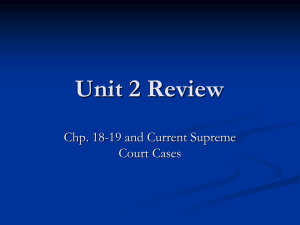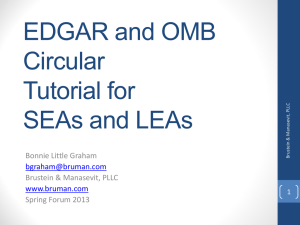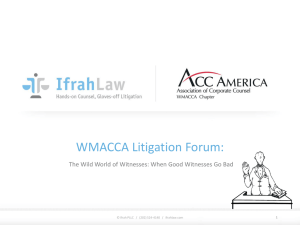
STATE INITIATIVES:
Pitfalls and Priorities
D. Faye Caldwell
fcaldwell@caldwelleverson.com
© Caldwell Everson PLLC. All rights reserved.
Traditional Testing Initiatives
Traditional drug testing initiatives can be
broken into three categories:
Mandatory testing of certain classes of
employees (e.g., state employees,
industry-specific).
Mandatory testing requirements for
discretionary workplace testing.
Voluntary testing requirements, which, if
observed, confer benefits on Employer.
© Caldwell Everson PLLC. All rights reserved.
Recent Initiatives
Post-accident
testing.
Pain management testing and
regulation.
State efforts to deal with
ramifications of medical marijuana in
workplace drug testing.
Unemployment benefits testing.
© Caldwell Everson PLLC. All rights reserved.
Mandatory Employee Testing
Typically, limited to state or public
employees.
◦ Florida
◦ Maryland
Some industry specific requirements.
◦ Home health care employees
◦ Professional athletes
◦ Miners
© Caldwell Everson PLLC. All rights reserved.
Example – Florida State Employee
Testing
Florida has one of the most
comprehensive workplace drug testing
programs in the nation.
Requirements include:
◦
◦
◦
◦
Lab licensure;
Collection site training requirements;
Mandatory cut-offs; and
Prohibitions on specimen types.
© Caldwell Everson PLLC. All rights reserved.
Mandatory Testing Requirements
For Discretionary Testing
Several states have mandatory
requirements for Employers who choose
to perform workplace drug testing.
These mandatory requirements include:
◦ Provisions related to the testing program
itself and enforceable against the Employer;
◦ Mandatory laboratory requirements
enforceable against the laboratory performing
the testing; and
◦ Mandatory collection requirements.
© Caldwell Everson PLLC. All rights reserved.
Example – Connecticut
Random drug testing is prohibited, unless
employee is in a safety-sensitive position
or enrolled in an EAP.
MRO is required.
Court decisions have held that urine
specimens must be collected as split
specimens.
Observed collections are prohibited.
© Caldwell Everson PLLC. All rights reserved.
Mandatory Laboratory Requirements
These statutes apply specifically to the
laboratory performing the workplace drug
testing and effectively limit the type of
testing that may be performed on workers in
that state.
Many states also have laboratory statutes
and regulations related to workplace drug
testing.
◦
◦
◦
◦
Kansas
Maine
Maryland
Nevada
© Caldwell Everson PLLC. All rights reserved.
Example – Maine
Test results must be reported in a way that
prevents Employers from being able to differentiate
between screen positive test results and confirmed
positive test results.
A Donor has the option of requesting a blood
sample be drawn for testing if required to submit to
testing for marijuana.
Provides mandatory cut-off levels.
Prohibits observed collections.
6-acetyl morphine, at a cut-off of 10 ng/mL, may
only be reported if morphine is greater than 2,000
ng/mL.
© Caldwell Everson PLLC. All rights reserved.
Example – Nevada
Clinical statute that covers toxicological
testing.
Requirements of specific personnel
qualifications, training and testing.
Currently undergoing revisions to both
statute and regulations that should be in
effect January 1, 2014.
© Caldwell Everson PLLC. All rights reserved.
Mandatory Collection Requirements
Example:
Iowa
◦ Split collection required.
◦ The Donor must be given an opportunity
to provide information on current
medication or other relevant medical
condition.
© Caldwell Everson PLLC. All rights reserved.
State Mandates related to Observed
Collections
© Caldwell Everson PLLC. All rights reserved.
States that Prohibit Observed
Collections
Connecticut
Maine
Rhode
Island
Also, Boulder CO prohibits observed urine
specimen collections.
© Caldwell Everson PLLC. All rights reserved.
Variances in Federal Standard
Adopted by State Scheme for
Observed Collections
Georgia – Public Employees
◦ Adopts HHS collection procedures
Indiana – Mining Industry
◦ Adopts HHS collection procedures
Tennessee – Workers’ Compensation
◦ Adopts DOT collection procedures
© Caldwell Everson PLLC. All rights reserved.
Who Decides When Observed
Collections are Required?
In addition to the actual procedure used,
state laws may also specifically provide
when and who may initiate an observed
collection.
◦ Collection site attendant
◦ DER
© Caldwell Everson PLLC. All rights reserved.
Voluntary Workers’ Compensation
Testing
Almost every state in the nation
mandates that Employers have workers’
compensation insurance coverage.
Workers’ compensation provides benefits
to employees injured on the job.
◦ Medical benefits and coverage
◦ Wage replacement benefits
◦ Lifetime disability benefits
© Caldwell Everson PLLC. All rights reserved.
Voluntary Workers’ Compensation
Testing: So Why do We Care?
Positive post-accident drug tests—if
performed in accordance with the
statutory requirements—create certain
presumptions regarding the cause of the
injury.
Many workers’ compensation statutes
include premium discount provisions for
Employers who implement the statutory
testing program.
© Caldwell Everson PLLC. All rights reserved.
What This Means for Participants
Employers stand to benefit from
adherence to these “voluntary” testing
requirements.
◦ Employers may incorrectly assume they are
receiving testing that complies with such
requirements.
Participants may be unaware of program
requirements.
◦ e.g., written policy requirements, collection
requirements, laboratory requirements.
© Caldwell Everson PLLC. All rights reserved.
Recent Initiatives
Workers’ Compensation Post-Accident
Drug Testing
Pain Management Testing
Medical Marijuana in the Workplace
Unemployment Benefits Testing
© Caldwell Everson PLLC. All rights reserved.
Workers’ Compensation Post-Accident
Drug Testing – Developing Field
How a presumption is important
In some states, a positive drug test result can
give rise to a “presumption” that
impairment—or drug use—caused the
accident or injury.
◦ These presumptions vary drastically between
states.
Such a presumption reduces the evidentiary
burden on Employers seeking to reduce
benefits to an employee testing positive for
controlled substances.
© Caldwell Everson PLLC. All rights reserved.
What Types of Presumptions are
Available to Employers?
Rebuttable
◦ A conclusion that a judge or jury must draw
when certain evidence has been introduced and
admitted as true.
◦ Can be overcome by employee if employee
presents sufficient evidence to the contrary.
Conclusive
◦ Employer no longer required to prove a fact –
the issue is conclusively established.
◦ Employee cannot submit evidence to the
contrary.
© Caldwell Everson PLLC. All rights reserved.
Rebuttable Presumptions
Presumption of Impairment
◦ Positive drug/alcohol test after accident provides
presumption employee was impaired at time of accident.
◦ No further proof from Employer required to establish
impairment.
◦ Puts the burden on the employee to prove not impaired.
Presumption That Impairment Was Cause of
Accident
◦ Positive drug/alcohol test after accident presumes
employee was impaired at time of accident.
◦ That impairment was cause of accident.
◦ Puts the burden on the employee to prove impairment
was not cause of accident.
© Caldwell Everson PLLC. All rights reserved.
Conclusive Presumptions
Not as common as rebuttable
presumptions.
Evidence of Impairment
◦ Current laws only provide for conclusive
presumption of impairment.
◦ Employee cannot rebut being impaired at time
of accident regardless of evidence.
Employer may be required to prove
impairment caused accident.
© Caldwell Everson PLLC. All rights reserved.
Example – Illinois
In 2011, Illinois revised its WC statute to
require split specimen collections for WC
post-accident testing.
◦ Legislature also tasked WC Commission with
promulgating additional testing regulations.
Regulations published in November 2012
raise questions as to obligations of
laboratories to report drug or metabolite
concentrations below standard cut-off levels,
an MROs interpretation of those results, and
compliance.
© Caldwell Everson PLLC. All rights reserved.
Example – Illinois cont’d
The Illinois Regulations require:
◦ The use of a 7-part form, and specific
certifications by collector and certifying scientist.
◦ Define a “positive” result and a specimen in
which a controlled specimen is present.
• No cut-offs provided by regulations.
• Concentration in urine admissible in hearings to show
impairment and intoxication.
◦ Regulations provide for different retention
periods of specimens than HHS/DOT.
◦ Failure to comply with requirements results in
loss of rebuttable presumption for Employer.
© Caldwell Everson PLLC. All rights reserved.
Example – Florida
Two different rebuttable presumptions
◦ When employee, at time of the injury, has a positive
drug/alcohol test, it is presumed that the injury
caused primarily by intoxication.
◦ If Employer has implemented drug-free workplace,
presumption rebutted only by evidence that there is
no reasonable hypothesis that the intoxication or
drug influence contributed to the injury.
◦ If Employer has not implemented drug-free workplace
program, presumption may be rebutted by clear and
convincing evidence that the intoxication or influence
of drugs did not contribute to injury.
© Caldwell Everson PLLC. All rights reserved.
Example – Kansas
In 2011, Kansas changed its WC statute:
◦ Positive drug/alcohol test using designated cutoffs is conclusive presumption of impairment.
◦ If impaired, rebuttable presumption that the
injury was contributed to by impairment.
◦ Employee may rebut presumption of contribution
by clear and convincing evidence.
◦ Many restrictions exist to get presumption,
including written policy containing specific items,
split specimen collection, collection by licensed
health care professional, HHS certified or Kansas
licensed testing laboratory.
© Caldwell Everson PLLC. All rights reserved.
Example – Alabama
Conclusive presumption of impairment.
◦ No compensation for accidents due to the
employee being intoxicated from use of alcohol
or being impaired by illegal drugs.
◦ Positive drug test conducted and evaluated
pursuant to DOT standards is conclusive
presumption of impairment resulting from the
use of illegal drugs.
◦ This requires all standards that would be used in
DOT test to be used in Alabama post-accident
testing, e.g., split specimen urine collection,
written policy, DOT cut-offs and testing
protocols, MRO review.
© Caldwell Everson PLLC. All rights reserved.
Example – Nevada
Rebuttable presumption.
If employee has any amount of a controlled
substance in his or her system at time of
injury without a valid prescription, the
controlled substance must be presumed to
be the proximate cause unless rebutted by
evidence to the contrary.
Testing must comport with Nevada testing
procedure and testing must be conducted at
a laboratory licensed by Nevada.
© Caldwell Everson PLLC. All rights reserved.
Example – Wyoming
Specific requirements.
Must meet DOT requirements for
collection and testing.
HHS laboratory must be used.
Specific testing cut-offs for alcohol and
drugs.
Specifics drugs provided.
© Caldwell Everson PLLC. All rights reserved.
Example – Wyoming cont’d
Specific drug-free workplace program requirements
include:
◦ Written policy.
◦ Statement providing for including all workers’ compensation
covered employees in testing program.
◦ Statement of required types of substance abuse testing.
◦ Statement of actions Employer may take on basis of positive test
result.
◦ Statement of consequences for refusal to submit to drug test.
◦ Confidentiality statement.
◦ Statement that employee may contest positive test result within
5 days after notification of test result.
◦ Statement affording provision of 60 days notice to
implementation of substance abuse testing.
◦ Locations for posting of policy.
© Caldwell Everson PLLC. All rights reserved.
Pain Management Testing – Developing
Field
Pain management testing, considered by many to
be clinical testing, is better considered “quasiforensic” because these test results could lead to
specific consequences, and may be challenged.
◦ Donor could lose pain management treatment if he
or she tests negative for an expected drug or positive
for other controlled substances.
◦ Donor could be physically removed from in-patient
rehabilitation or addiction treatment center.
There is an ongoing discussion regarding what
constitutes “forensic defensibility” in these new
non-employment applications.
© Caldwell Everson PLLC. All rights reserved.
Example – Tennessee
Drug testing is required for pain
management patients.
◦ Medical Director of clinic must have a written
drug screen policy and compliance plan for
employees.
• Urine test required for each new admission and
once every six months.
• Must keep urine drug screen results on file.
© Caldwell Everson PLLC. All rights reserved.
Example – Ohio
Drug testing is discretionary.
◦ Practitioner can obtain a drug screen based
on evidence or behavioral indications of
addiction or drug abuse.
• Discretion to decide nature of screen and drugs to
be screened.
◦ If practitioner believes patient is suffering
from addiction or drug abuse, must contact
specialist immediately.
• Patient might be placed in substance abuse
treatment facility.
© Caldwell Everson PLLC. All rights reserved.
Medical Marijuana – Developing
Field
Medical
marijuana is now legal in many
states.
Still illegal under federal law.
Recent Trends
◦ Almost half of the laws have been passed since
2010.
Laws have specific requirements to obtain
medical marijuana.
◦ Registration.
◦ Specific conditions.
© Caldwell Everson PLLC. All rights reserved.
Medical Marijuana and Workplace Drug
Testing
Developing
area of law.
Most Laws Only Protect Against
Criminal Charges
◦ So far, the laws do not accommodate
marijuana use in workplace.
◦ Oregon, California, Washington and Michigan
• Cases explicitly finding employees not protected.
• Casias v.Walmart: Wal-Mart employee tested
positive while legally on medical marijuana, no
wrongful termination.
© Caldwell Everson PLLC. All rights reserved.
Medical Marijuana, cont’d.
Newer Laws Providing Protection for Employees
◦ Rhode Island and Maine: cannot refuse to “employ” or
“otherwise penalize” an employee.
◦ Arizona and Delaware - Specifically address marijuana drug tests,
not grounds for termination for medical marijuana usage.
Legal Off-Duty Use Statutes
◦ Separate from medical marijuana statutes.
◦ Colorado and Nevada have broad off-duty use statutes Employer cannot discriminate for legal use of product off-duty.
◦ Coats v. Dish Network, L.L.C., 303 P.3d 147 (Colo. Ct. App. April 25,
2013)
• Appellate court split decision found that otherwise provided no defense to
termination for marijuana use.
• Appeal likely.
© Caldwell Everson PLLC. All rights reserved.
Medical Marijuana, cont’d.
Recent Cases On Medical Marijuana
◦ Curry v. MillerCoors, Inc., (D. Colo. Aug. 21, 2013)
• Dismissed employee’s claim that he was terminated
for lawful medical marijuana use.
• Found Colorado’s medical marijuana law provides no
employee protection.
◦ James v. City of Costa Mesa (9th Cir. 2012)
• ADA does not protect medical marijuana users who
claim to face discrimination on the basis of their
marijuana use, since federal law defines marijuana as
an illegal drug, state medical marijuana law immaterial
under federal statute.
© Caldwell Everson PLLC. All rights reserved.
Unemployment Benefits Testing
The Middle Class Tax Relief and Job
Creation Act of 2012
◦ Federal law amended the Social Security Act
allowing states to drug test applicants for
unemployment benefits in February 2012.
◦ States can test claimants who are in an
“occupation that regularly conducts drug
testing.”
• DOL to provide regulation listing permitted
occupations, but has not yet done so.
© Caldwell Everson PLLC. All rights reserved.
Unemployment Benefits Testing
Recent state initiatives to subject
unemployment benefit recipients to drug
testing.
Also initiatives to test welfare recipients.
Very recent developments in testing laws.
◦ Testing standards not uniformly adopted.
◦ States taking different approaches to testing
requirements, if testing at all.
© Caldwell Everson PLLC. All rights reserved.
Example – Texas
Law effective September 1, 2013, with first
testing to occur on claimants on or after
February 1, 2014.
◦ Claimant must complete a drug assessment
questionnaire.
• If questionnaire indicates “reasonable likelihood” of
substance abuse, individual must pass a drug test
administered by workforce commission to obtain
benefits.
◦ Regulatory rules to be developed.
© Caldwell Everson PLLC. All rights reserved.
State Testing Initiatives: In Sum
Numerous states provide for mandatory
testing schemes, or in some instances,
mandatory Laboratory testing requirements
for testing of Donors in that state.
Many states also provide voluntary workers’
compensation programs, which only confer
benefits if testing requirements are met.
Participants must be aware of these different
schemes in the states in which they operate.
Legal obligations will vary depending on the
type of testing, even within a state.
© Caldwell Everson PLLC. All rights reserved.
QUESTIONS
© Caldwell Everson PLLC. All rights reserved.









